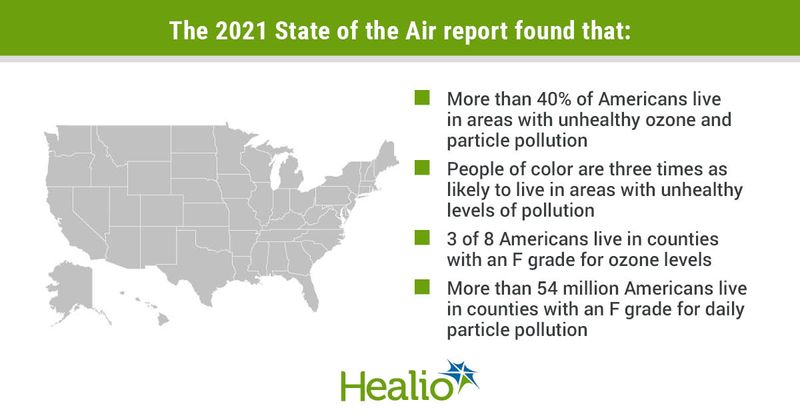4 in 10 Americans live in areas with unhealthy pollution levels
More than 40% of Americans live in areas with unhealthy pollution levels, and people of color are three times as likely to live in a county with polluted air, according to the American Lung Association’s 2021 State of the Air report.
The report is based on data from 2017, 2018 and 2019, which were the 3 years with the most recent quality-assured data from the U.S. Environmental Protection Agency. Data on air quality were collected at official monitoring sites across the U.S. by federal, state, local and tribal governments.

Each year, State of the Air reports on the two most widespread outdoor air pollutants: ground-level ozone pollution and particle pollution.
According to the 2021 report, 41.1% of Americans — more than 135 million — live in the 217 counties with unhealthy ozone and particle pollution levels, which is 14.8 million fewer than reported in last year’s report. However, the 2021 report highlights an increase of nearly 1.1 million individuals living in areas with unhealthy short-term particle pollution levels.
“This report shines a spotlight on the urgent need to curb climate change, clean up air pollution and advance environmental justice,” Harold Wimmer, CEO and president of the American Lung Association (ALA), said in a press release. “The nation has a real opportunity to address all three at once — and to do that, we must center on health and health equity as we move away from combustion and fossil fuels to clean, renewable energy.”
New data on particle pollution
Unhealthy particles in the air come from wildfires, wood-burning stoves, coal-fired power plants, diesel engines and other sources. Also known as PM2.5, these particles can trigger asthma exacerbations, heart attacks and strokes and can cause lung cancer and even death.
Nearly 54.4 million people in the U.S. lived in 88 counties with dangerous spikes in short-term particle pollution. This number is more than in any of the previous five State of the Air reports, according to the release.
The 10 cities most polluted by short-term particle pollution (24-hour PM2.5) were:
- Fairbanks, Alaska
- Fresno-Madera-Hanford, California
- Bakersfield, California
- San Jose-San Francisco-Oakland, California
- Yakima, Washington
- Los Angeles-Long Beach, California
- Logan, Utah-Idaho
- Redding-Red Bluff, California
- Missoula, Montana
- Sacramento-Roseville, California
In addition, more than 20.9 million people lived in counties with unhealthy levels of year-round particle pollution, according to the release.
The 10 cities most polluted by year-round particle pollution (annual PM2.5) were:
- Bakersfield, California
- Fresno-Madera-Hanford, California
- Visalia, California
- Los Angeles-Long Beach, California
- Medford-Grants Pass, Oregon
- Fairbanks, Alaska
- San Jose-San Francisco-Oakland, California
- Phoenix-Mesa, Arizona
- Pittsburgh-New Castle-Weirton, Pennsylvania-Ohio-West Virginia
- El Centro, California
Ozone pollution
In 2017, 2018 and 2019, more than 123.2 million Americans lived in 163 counties that earned a failing grade for ozone levels. In the list of 25 U.S. cities with the worst ozone pollution, Los Angeles remained the city with the worst pollution in the nation, followed by Bakersfield, California, and Visalia, California. U.S. cities in the West and Southeast had the highest ozone pollution levels, with 10 of the 25 most-polluted cities in California.
According to the report, the geographic distribution of cities with worse ozone pollution confirmed a trend observed during the past five reports that showed more pollution among U.S. cities in the East and West. Increased oil and gas extraction in the Southwest and power plant cleanup in the East shifted cities experiencing greater unhealthy ozone days, but problems continue to arise in the East with transported ozone pollution from upwind sources in the Midwest, according to the report.
Along with geographic trends, this report also highlighted the role high temperatures play in unhealthy ozone levels, as 2017, 2018 and 2019 rank among the six hottest years globally on record. These findings suggest that climate change drives warmer temperatures and, therefore, causes more ozone pollution to form and makes it harder to clean.
The “cleanest” U.S. cities, defined as those with no high ozone or particle pollution days and rank among the 25 cities with the lowest year-round particle pollution levels were:
- Burlington-South Burlington-Barre, Vermont
- Charlottesville, Virginia
- Elmira-Corning, New York
- Honolulu, Hawaii
- Wilmington, North Carolina
Disparities in air quality
Of the 20.7 million Americans living in counties with at least one failing ozone and/or particle pollution grade, 14 million were people of color. This report found people of color were 61% more likely to live in these specific counties and more than three times as likely to live in counties failing for all three pollutants compared with white individuals.
All Americans living in areas with unhealthy ozone or particle pollution levels are at risk, but the 2021 State of the Air report highlighted specific groups of individuals who are considerably more vulnerable to illness and death from air pollution exposure. These groups of higher-risk individuals living in counties with at least one failing ozone and/or particle pollution grade include:
- people of color (70 million);
- people living in poverty (15.8 million);
- Children and older adults (30.6 million children and 20.1 million adults aged 65 years and older); and
- people with smoking histories (14.6 million).
Along with those groups, the ALA also highlighted the importance of lowering pollution levels for the health and safety of individuals with underlying health conditions who also live in counties with at least one failing ozone and/or particle pollution grade, including:
- people with asthma (2.3 million children and 9.2 million adults);
- people with COPD (5.9 million);
- people with lung cancer (67,000); and
- people with cardiovascular disease (7.9 million).

